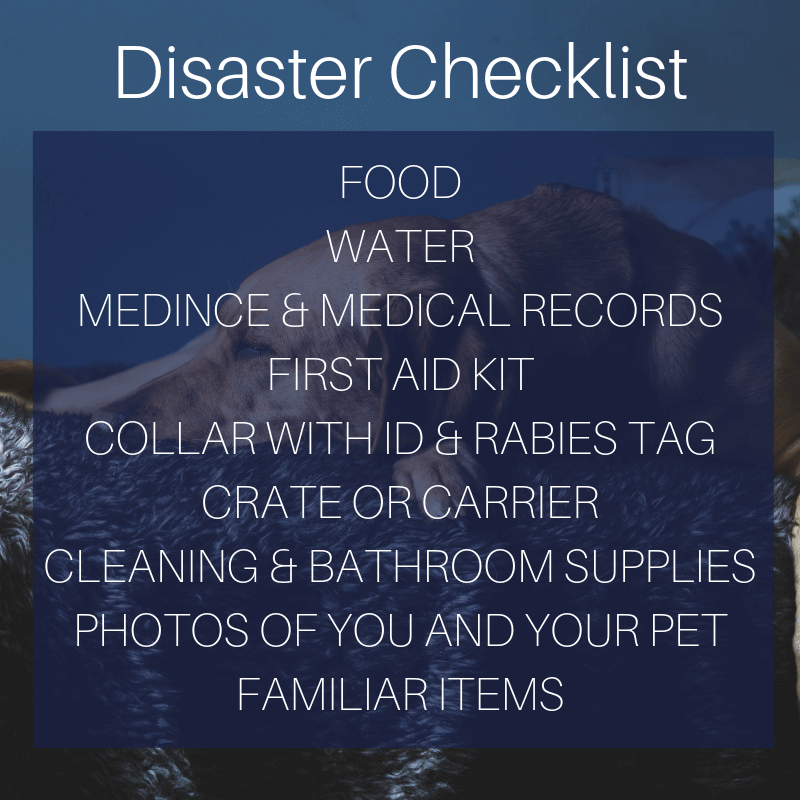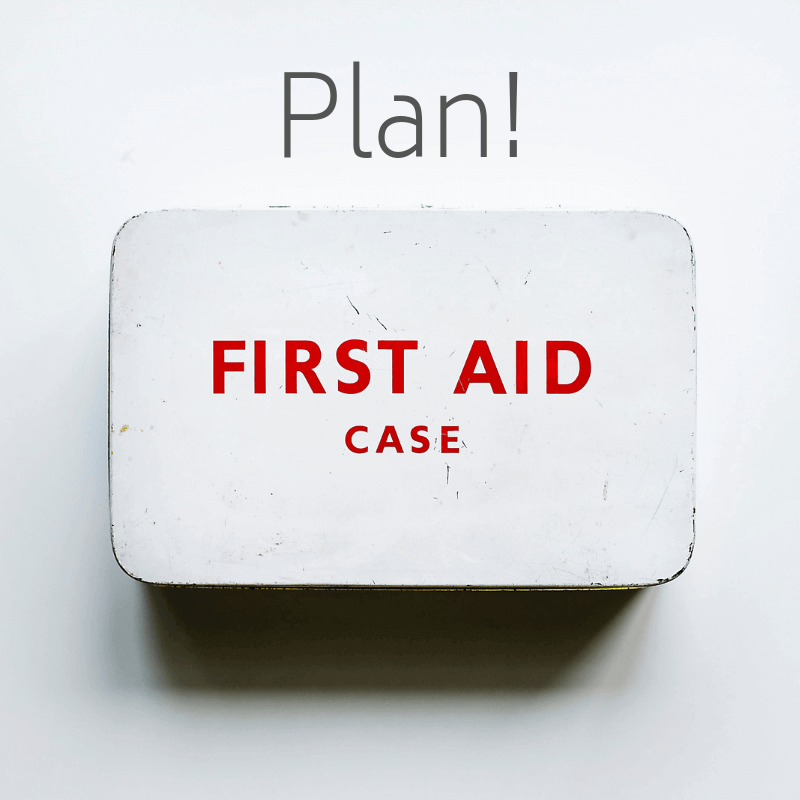With the summer months comes Hurricane season in the South. While we may be far enough away from the coast to not get the full effect, Hurricane Matthew showed us we should still be prepared for the worst.
Don't Wait!
Temporary evacuations may not stay temporary and can often turn into extended time away from your home. Always take your pets with you. Be prepared with a small to-go bag for each pet. This will cut off valuable time if you do need to evacuate. It's always best to be overly cautious in emergency situations. As a worse case, be prepared for a loss of utilities such as power, water, and gas and as a last resort have an evacuation plan to safely and quickly move your entire family away from the disaster.
FEMA suggests three steps.
1. Prepare
Just like the rest of your family, you should have a small 'to-go' bag with the necessities for your pet to survive outside of the home. 
- Food: You should bring enough food to last for three days. Store in an airtight and waterproof container.
- Water: You should bring enough clean water to last for three days.
- Medicine and medical records: You should always have a copy of your pets medical records with proof of vaccines as well as any treatments or ongoing health problems. This will help if your pet has any health emergencies and needs to see a different Veterinarian.
- First Aid Kit: Like the family first aid kit, you should put together an animal one in case of emergencies while evacuating. We will go over what to include in this later on.
- Collar with ID tag, harness or leash: Your pet should always have their ID tag and Rabies tag on them in case they get lost. Consider other, permanent options such as microchipping to ensure your pet can be found and recovered if lost.
- A crate or carrier: In case of evacuation, a crate will not only make the process easier, but crates also tend to make many pets feel safe. Prep your emergency crate with blankets and other articles of clothing that smell like you or ones your pet is used to sleeping on. This can help reduce stress for your pet and ultimately you as well.
- Pet cleaning and bathroom supplies: If you are on the road, the last thing you need is your cat going to the bathroom in your car. Bring a small litter box and extra litter with you. Consider also bringing a small cleaning kit with non-scented sanitizing supplies for on the go cleaning as well as a few poop bags for your dog.
- Photos of you and your pet: If, worst case, you and your pet get separated any proof of ownership will help you retrieve them. Photos as well as knowing any identifying features such as breed, sex, weight, color, etc will help emergency personnel and shelters identify your pet. Microchipping your pet as well as keeping up to date pet ID tags with your full information will also help assist in proving ownership.
- Familiar items: Evacuating is a stressful event for everyone involved. Pack your pets emergency crate or carrier with familiar items such as toys, treats, and bedding to help reduce your pets stress levels.
You should also prepare a pet, Frist Aid Kit to bring with you. Having a First Aid Kit outside of an evacuation is also a good idea in case of other emergencies you and your pet may face. For other first aid emergencies, see our blog 'PET FIRST AID'
- Important phone numbers: Keep a list of important phone numbers such as your vet's office, the closest e-clinic, animal control, and poison control. You may also keep them as saved contacts in your phone for easy access.
- Vaccine and medical history: Keeping an up to date records of your pets medical history is a huge help for a Veterinarian in case you are unable to bring them into your normal vet. With our new app PetPro Connect, you can keep your pet's up to date records with you at all times!
- Muzzle: When your pet is hurt they may react out of character and try to bite. A muzzle is a safety precaution for emergency vets, techs, and other personnel your pet may not know handling their emergency.
- Spare leash or collar: In the event you need to cut away your pet's collar or leash, make sure you have a backup.
- Gauze: Gauze can be used to both cover a wound but also as a soft muzzle for an injured pet.
- Clean towels: Towels can be used to help restrain an injured cat, for clean up or even padding.
- Non-stick bandages or strips of clean cloth: These can be used to wrap a wound and help control bleeding.
- Self-adhering, non-stick tape: Used to secure bandages.
- Eyedropper: You can use an eyedropper or a large syringe without the needle to help clean and flush wounds.
- K-Y Jelly: Can be used to help protect wounds and eyes.
- Milk of Magnesia or Activated Charcoal: Both can be used to help absorb poison (Should be used only if instructed to by your veterinarian or a poison control official).
- 3% Hydrogen Peroxide: to induce vomiting. (Should be used only if instructed to by your veterinarian or a poison control official, do not use Hydrogen Peroxide on open wounds).
- Saline solution: Saline can be used to clean wounds. Contact solution works well and maybe already in your home.
2. Plan
What would you do in case of a hurricane or other natural disasters? Where would you go? Do you have family out of the emergency area you can stay with? Is your home built to withstand the income weather? Are you going to evacuate or stay pat? In both scenarios, you should have a general idea of what you and your family would do. 
- Create a plan to evacuate: Plan how you would assemble your family and pets and where you would go. If you plan on going to a public evacuation center you may not be able to bring your pets with you. Consider family or friends willing to take you and your pets in, or know the local veterinary or boarding facilities in the area where your pets can stay. You can also consider a hotel or motel with pet-friendly accommodations. Consider looking into all your options beforehand. Contact veterinary or boarding facilities and see what is required for your pet to stay. All work done before an emergency will give you more time to focus on getting away quickly and safely.
- Create your own 'Buddy System': Plan with neighbors, family, and friends in case you are unable to bring your pets with you. Consider setting two an emergency meet-up location where someone can meet you and bring your pets. One in your immediate location and another farther away.
- Talk to your pet's veterinarian about emergency planning: We are more than happy to help you with planning your evacuation checklist and providing our advice on what you should do in case of an evacuation. We may also recommend microchipping your pet in case you are separated so they can be returned home.
- Create a list of pets for emergency personnel: In case you are not home and have to immediately evacuate, keep a list of all pets in the house near your pet supplies. Put name, species, size, temperament, and favorite hiding spots. This can be a huge time saver for rescue personnel. Designate a neighbor willing to look after your pets in your absence and consider noting your veterinarian in case your pets need treatment.
3. Stay informed.
If you know a storm or other inclement weather is on its way, keep an eye out on the news, listen to the radio, or stay alert for emergency broadcasts. It's important to stay informed so you can make quick decisions if things take a turn for the worse.
Common emergency situations based on past emergencies in our areas include Winter Weather, Severe Weather, Flooding, Tropical Storm/Hurricane, Heat Advisories. Ready.gov has many great resources about emergency preparedness for the whole family.
If you have any questions about your family's emergency plan in regards to your pet, please contact us today!
